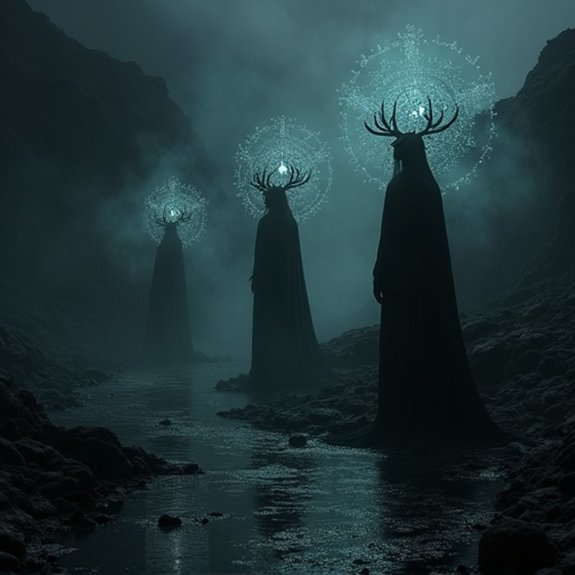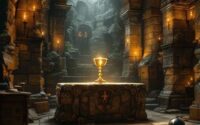The Chthonic Deities of the Underworld
The ancient world’s chthonic deities don’t merely represent death—they’ve shaped humanity’s understanding of existence itself. These underground gods controlled both the afterlife and earthly abundance, wielding power that terrified and sustained entire civilizations. From Mesopotamian temples to Greek mystery cults, worshippers performed secretive rituals to appease these dual-natured beings. What they discovered about death’s relationship to life would challenge everything modern society believes about the underworld.
Introduction

The ancient world’s chthonic deities ruled over death, the underworld, and the mysterious forces beneath the earth’s surface. These powerful beings governed the afterlife across diverse cultures, from Greek Hades to Egyptian Osiris, Norse Hel to Mesopotamian Ereshkigal. They weren’t merely death gods but complex entities who controlled earthly fertility, mineral wealth, and agricultural abundance sprouting from below.
Chthonic deities embodied humanity’s dual relationship with the underground domain—both feared as death’s domain and revered as life’s source. They received different worship than sky gods, often through nighttime rituals, blood sacrifices, and offerings poured directly into the earth. Understanding these deities reveals how ancient peoples conceptualized mortality, justice, and regeneration. Their myths shaped burial practices, mystery religions, and philosophical beliefs about the soul’s journey after death.
Ancient Mesopotamian Death Cult Practices
While scholars have uncovered extensive evidence of Mesopotamian death practices, these ancient peoples didn’t worship death itself but rather sought to appease the dead through elaborate rituals. They believed the deceased continued existing in Irkalla, a dark underworld ruled by Ereshkigal and her consort Nergal. Monthly offerings of food and water sustained the dead’s spirits, preventing them from returning as vengeful ghosts.
Burial customs reflected social hierarchy—elites received tombs with grave goods while commoners got simple interments. Priests performed kispu ceremonies, where families shared ritual meals with their ancestors. The living poured libations through clay pipes directly into graves. These practices weren’t death worship but practical measures to maintain cosmic order. Mesopotamians feared the dead’s potential for chaos if neglected, making regular offerings essential for societal stability.
Notable Cases or Sightings

Although ancient texts don’t record “sightings” of chthonic deities in the modern sense, several documented encounters with underworld beings appear throughout classical literature and archaeological records. Odysseus’s consultation with Tiresias in the underworld provides one famous account, while Aeneas’s descent guided by the Sibyl offers another. Archaeological evidence from Babylonian tablets describes priests’ ritualistic communications with Ereshkigal through dream incubation practices.
Greek mystery cults at Eleusis claimed direct contact with Persephone during initiation rites. Roman sources detail apparitions of Dis Pater near volcanic vents, particularly around Mount Vesuvius. Medieval grimoires later referenced these classical accounts, incorporating summoning procedures for entities like Hecate. These narratives shaped Western occultism‘s approach to underworld communication, though they’re better understood as religious experiences than literal sightings.
Common Theories or Explanations
Because chthonic deities appear across unconnected cultures worldwide, scholars have proposed several explanations for their universal presence in human mythology. Jung’s collective unconscious theory suggests these deities represent humanity’s shared psychological patterns regarding death and the unknown. They’re archetypal expressions of universal fears and transformations.
Anthropologists argue that agricultural societies developed underworld gods to explain seasonal cycles—seeds buried underground before sprouting mirror death and rebirth narratives. The earth’s fertility depends on decomposition, linking chthonic powers to both destruction and renewal.
Geological theories propose that volcanic activity, earthquakes, and caves inspired beliefs about subterranean domains inhabited by powerful beings. Ancient peoples couldn’t explain these phenomena scientifically, so they attributed them to divine forces below.
Psychological interpretations view chthonic deities as projections of repressed desires and shadow aspects of human nature that societies bury beneath conscious awareness.
Frequently Asked Questions
What Offerings or Rituals Are Traditionally Used to Honor Chthonic Deities Today?
Modern practitioners honor chthonic deities through libations of wine, honey, or milk poured into the earth. They’ll leave food offerings at crossroads, burn incense, and conduct nighttime rituals involving candles, stones, and underground symbols.
How Do Chthonic Deities Differ From Other Underworld Entities Like Demons?
Chthonic deities rule over death and earth’s fertility as divine powers, while demons typically serve as malevolent spirits or servants. They’re gods with authority over underworld domains, whereas demons don’t possess godlike sovereignty or worship.
Which Modern Religions Still Incorporate Chthonic Deity Worship Into Their Practices?
Several modern religions still honor chthonic deities. Hindus worship Bhumi Devi, the earth goddess. Some Hellenic reconstructionists venerate Hades and Persephone. Vodou practitioners serve the Gede lwa, who’re spirits governing death and fertility domains.
What Symbols or Iconography Are Commonly Associated With Chthonic Deities?
Chthonic deities commonly feature serpents, caves, torches, pomegranates, cypress trees, and keys in their iconography. They’re often depicted with dark robes, holding staffs, accompanied by three-headed dogs, or emerging from earth’s cracks.
Can Chthonic Deities Influence the World of the Living?
Yes, chthonic deities influence the living world through fertility, agricultural cycles, mineral wealth, earthquakes, and volcanic activity. They’re believed to control fate, send prophetic dreams, curse mortals, and govern the transformation between life and death.


